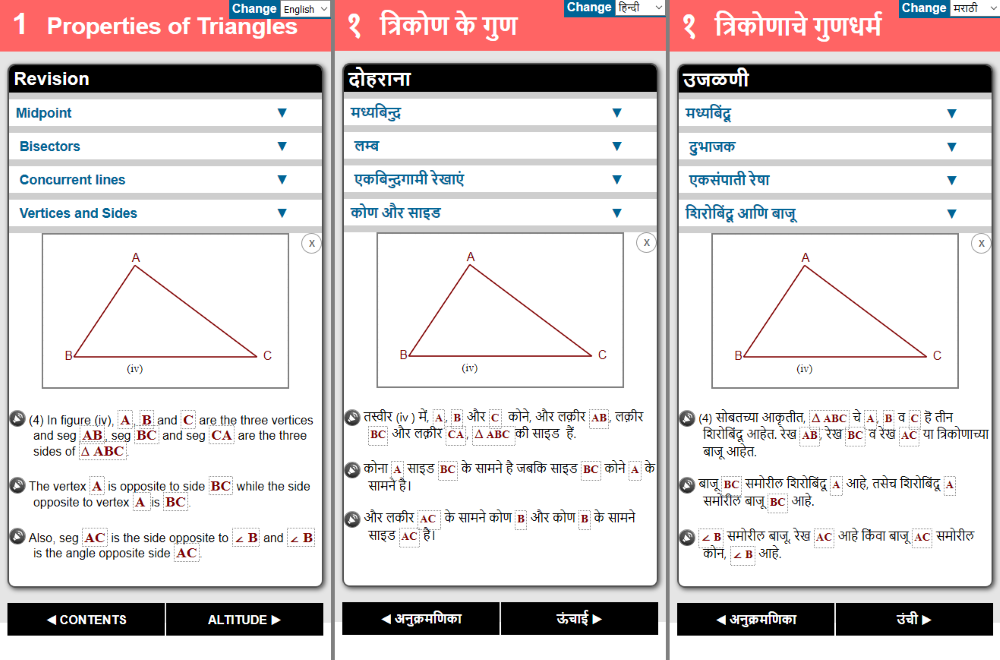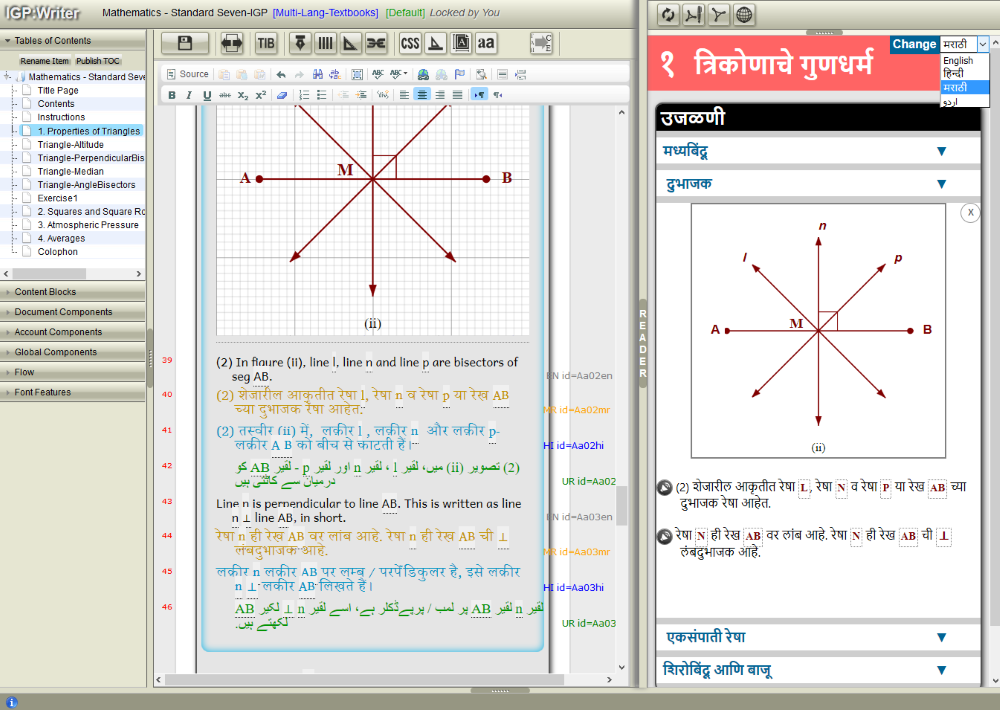Multi-language e-Textbooks
12 December 2015
We are producing multi-language digital textbooks for both mixed language majorities and ethno-linguistic minorities.
We are producing multi-language digital textbooks for both mixed language majorities and ethno-linguistic minorities. Currently the target users are in various states and regions in India but the lessons we are learning apply around the world in multi-language environments, especially in the developing world. (We are talking K-12 education in this article, not tertiary textbooks.)
Multi-language digital content has many interesting dimensions and challenges. Because we develop and maintain both the production tools (IGP:Digital Publisher) and e-book delivery solutions (AZARDI:Content Fulfilment) with the AZARDI Reading Systems for all platforms, we are able to address the these unique challenges and in many respects make them as easy to create as they should be.
The Current ePub?3? Reader Challenges
It is currently impossible to create highly interactive educational content without targeting specific ePub3 reading systems that don't enforce the arbitrary IDPF restrictions. The IDPF ePub3 specification is relatively "anti-interactive content" (although they would claim the opposite) and certainly doesn't help at all with multi-language books. This reflects in most ePub3 reading systems which are trying hard to be print-book like in their content presentation, imitate the limitations of iBooks and Kindle, or in fixed layout versions act like Adobe Flash. All this ignores the wide screen sizes and aspect ratios used in real-word education content delivery in developing world scenarios.
The current digital content bottom line is that a publisher has to either:
- Product e-textbook content that has been dumbed down for the lowest reading platform (Amazon Kindle) if they want e-Retailer distribution. This makes it impossible for publishers to innovate with new digital content strategies for new business models. The option is inflexible "Apps" which cost a fortune to create and maintain and deliver little:
Or:
- Produce highly interactive education content for delivery to ePub3 reading systems that will allow new learning content innovation beyond book replication with a few widgets. The upside of this approach is being able to do new things with digital content. Because we have AZARDI Reading Systems for all platforms and AZARDI:Content Fulfilment for the delivery of that content the new-content challenge can be delivered.
We use IGP:Digital Publisher to produce the content in a delivery system neutral way and then process it for delivery to ePub3 (standard), ePub3(extended), static sites and even print. We strongly believe in "Digitize Once. Use Forever." and that means exploiting HTML5, CSS-3 and Javascript while dynamically updating for new and different package specifications as they become available.
Multi-language Book Strategies
There are a number of practical options and approaches to creating multi-language books. We tried and tested them to discover what works at the learning level with highly interactive aural textbooks in multiple languages in our target mixed ethno-linguistic communities with low mother-tongue literacy.
Aural textbooks is a “sort-of” new concept. Basically it is the text being read against an animated illustration of the concept being presented AND optionally the text being read with concept words highlighted rather than just the word/phrase reading sequence as would be done with SMIL.
The easiest metaphor is a teacher explaining things at the blackboard. The difference is of course that the explanation can be played any number of times in any preferred language and has associated illustrated and interactive practice and text exercises. Aural textbooks are effectively “accessibility” for students with low literacy levels in their mother tongue or instructional language; especially low reading skills.
1. Separate Language Editions
Having a separate e-Book for each language is the traditional approach and follows the print production/distribution model. In many respects this is the easiest approach. However the rigidity of this approach creates complications when learning environments themselves are mixed and multiple languages and literacy levels are low. It has the same potential to fail these communities as print has failed.
2. Assembled Language Editions
With this model one e-Book package contains multiple language editions so there is a language edition navigation page for the users. It is effectively an omnibus edition. Once a user is in a language frame they can navigate with that language internally. AZARDI has a language reading preference option which allows the user to only see their language preference. The downside here is the book is large because illustrations, interactivity and other components are largely repeated for each language. This significantly bloats the size of the delivered package.
3. Section Assembled Language Editions
Because textbooks generally encapsulate lessons, concepts and exercises by chapter, section language grouping is a possible alternative. We evaluated this approach but there were no significant advantages over option 2. Assembled Language Editions.
4. Parallel Language Editions
The final option we looked at (reluctantly at first), and the packaging we have adopted is parallel languages by paragraph. There are a number of reasons that this seemingly complicated approach emerged as the best approach.
Interactive exercises and illustrations only have to be put into the package once and all languages can access them. We mainly use SVG for illustrations and can implement multi-language labelling in SVG very easily. This means the total package size is significantly reduced for multi-language delivery.
Aural learning is a big feature of these textbooks. This means up to five languages are available to be played back on a language by language basis and the user can easily change between languages on any learning concept. In addition we have implemented a new feature in AZARDI:Content Fulfilment where the user can select which of the packaged languages they want transferred to their device. This reduces the size (and cost) of the transfer.

A mathematics textbook concept example in English, Hindi and Marathi on a standard 5in Android smartphone screen.
Digital Content Benefits for multi-language textbooks
Compared with print, digital content production and delivery costs are slashed for multiple language content. It allows the production of digital textbooks for linguistic minorities where with print they are impractical, if not impossible to produce.
While this may not seem important from a western language perspective, considerable research has shown core mother tongue reading and numeric skills development up to year 2, makes it a lot easier for a student to start learning a second language as their education moves forward.
With the right production and delivery tools, adding a language in an aural digital textbook is the cost of a translator, narrator and production editor. The book can then be made immediately available to end users.
Production and Delivery Challenges
This production challenges for this work meant a serious change of approach to digital book production and packaging. The books are created in IGP:Digital Publisher. Parallel language editorial and production meant we had to move the HTML5 [lang] attribute to the top of the attribute tree. Fortunately in 2015 browsers do pretty good job of language presentation (assuming you use appropriate fonts) and the brilliance of the work of the Unicode Consortium has to be mentioned with glowing praise and thank-yous.

The IGP:Digital Publisher production editor interface has been optimized for multi-languages with colour coding and lang patterned IDs (left). The reader emulator on the right shows four available languages with Marathi selected. The different sections expand and display the learning concept.
We have developed custom translation interfaces so translators only have to address their target language from their preferred source language. They don't have to engage with the complication of other languages that may be translated by other people. When a new language is required they click one button and paragraph stubs in that language are inserted.
Standardizing Delivery Packages
IGP:Digital Publisher can output many formats, but at present we are mostly processing the output books as ePub3. This very developed-economy format has it's own set of challenges as a delivery format for education in the developing world. For example parallel language metadata and book catalog information cannot be addressed in the packaging rules. The IDPF and ePub any number is very rigidly focused on trade print books with a few extras for other genres.
In addition ePub3 has their backward-looking restrictions on the use of standard HTML5/CSS3 to keep the reading systems baselined down to the lowest common performance. The faster publisher content moves beyond the decade old "vision" of the grand-dads in the IDPF the better for the children in the developing world.
We wait with anticipation for the new W3C standards for Web-App packaging so content can be delivered anywhere to any device at any time.
Coming Soon
We will post more articles on the production and delivery of this very different digital content model. There is limited dialogue on the mother-tongue learning challenge anywhere. In countries like India students must go on to learn at least two and often three additional languages beyond their mother tongue. Education content needs to reflect this challenge.
Penetration of Android smartphones is reaching incredible highs around the world and is a technology adoption intensity that has never been seen before. The core driver of this uptake is simply family communication into rural areas. Communication that was impossible only a few years back. These smart phones must be the primary target for education content delivery. The Internet and global connectivity is changing everything.
Publishing in general and education publishing in particular need to exploit this technology change at the pace it is happening. We are on the starting line.
Posted by: Richard Pipe